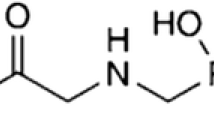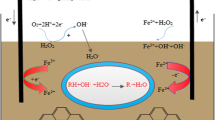Abstract
Soil is widely used as adsorbent for removing toxic pollutants from their aqueous solutions due to its wide availability and cost efficiency. This study investigates the potential of soil and soil composites for removal of crystal violet (CV) dye from solution on a comparative scale. Optimisation of different process parameters was carried out using a novel approach of response surface methodology (RSM) and a central composite design (CCD) was used for determining the optimum experimental conditions, as well as the result of their interactions. Around 99.85 % removal of CV was obtained at initial pH 6.4, which further increased to 99.98 % on using soil and cement composite proving it to be the best admixture of those selected. The phenomenon was found to be represented best by the Langmuir isotherm at different temperatures. The process followed the pseudo-second-order kinetic model and was determined to be spontaneous chemisorption in nature. This adsorbent can hence be suggested as an appropriate liner material for the removal of CV dye.








Similar content being viewed by others
References
Alshabanat M, Alsenani G, Almufarij R (2013) Removal of crystal violet dye from aqueous solutions onto date palm fiber by adsorption technique. J Chem. doi:10.1155/2013/210239
Amini M, Younesi H, Bahramifar N, Lorestani AAZ, Ghorbani F, Daneshi A, Sharifzadeh M (2008) Application of response surface methodology for optimization of lead biosorption in an aqueous solution by Aspergillus niger. J Hazard Mater 154:694–702
Anirudhan TS, Radhakrishnan PG (2008) Thermodynamics and kinetics of adsorption of Cu_II_ from aqueous solutions onto a new cation exchanger derived from tamarind fruit shell. J Chem Thermodyn 40(4):702–709
Banerjee P, Sarkar S, Dey TK, Bakshi M, Swarnakar S, Mukhopadhyay A, Ghosh S (2014) Application of isolated bacterial consortium in UMBR for detoxification of textile effluent: Comparative analysis of resultant oxidative stress and genotoxicity in catfish (Heteropneustes fossilis) exposed to raw and treated effluents. Ecotoxicology 23(6):1073–1085
Chowdhury S, Chakraborty S, Saha PD (2013) Response surface optimization of a dynamic dye adsorption process: a case study of crystal violet adsorption onto NaOH-modified rice husk. Environ Sci Pollut Res 20:1698–1705
Hamsaveni DR, Prapulla SG, Divakar S (2001) Response surface methodological approach for the synthesis of isobutyl butyrate. Process Biochem 36:1103–1109
Jain M, Garg VK, Kadrivelu K (2011) Investigation of Cr(VI) adsorption onto chemically treated Helianthus annus: optimization using response surface methodology. Bioresour Technol 102:600–605
Jaman H, Chakraborty D, Saha P (2009) A study of the thermodynamics and kinetics of copper adsorption using chemically modified rice husk. Clean Soil Air Water 37(9):704–711
Pino GH, de Mesquita LMS, Torem ML, Pinto GAS (2006) Biosorption of cadmium by green coconut shell powder. Miner Eng 19:380
Pourbabaee AA, Malekzadeh F, Sarbolouki MN, Najafi F (2006) Aerobic decolorization and detoxification of a disperse dye in textile effluent by a new isolate of Bacillus sp. Biotechnol Bioeng 93(4):631–635
Robinson T, McMullan G, Marchant R, Nigam P (2001) Remediation of dyes in textile effluent: a critical review on current treatment technologies with a proposed alternative. Bioresour Technol 77:247–255
Saha P, Datta S (2009) Assessment on thermodynamics and kinetics parameters on reduction of methylene blue using flyash. Desalin. Water Treat 12:219–228
Saha P, Sanyal SK (2010) Assessment of the removal of cadmium present in wastewater using soil–admixture membrane. Desalination 259:131–139
Saha P, Chowdhury S, Gupta S, Kumar I (2010) Insight into adsorption equilibrium, kinetics and thermodynamics of malachite green onto clayey soil of Indian origin. Chem Eng J 167:874–882
Satapathy MK, Das P (2014) Optimization of crystal violet dye removal using novel soil-silver nanocomposite as nanoadsorbent using response surface methodology. J Environ Chem Eng 2:708–714
Satapathy MK, Banerjee P, Das P (2013) Plant-mediated synthesis of silver-nanocomposite as novel effective azo dye adsorbent. Appl Nanosci. doi:10.1007/s13204-013-0286
Acknowledgements
The authors express their gratitude to the Department of Science and Technology, India for sanctioning the financial support under SERB-DST-Fast Track Young Scientist (Ref: SR/FTP/ETA-083/2011) towards successful execution of this research work.
Author information
Authors and Affiliations
Corresponding author
Additional information
Responsible editor: Michael Matthies
Rights and permissions
About this article
Cite this article
Das, P., Banerjee, P. & Mondal, S. Mathematical modelling and optimization of synthetic textile dye removal using soil composites as highly competent liner material. Environ Sci Pollut Res 22, 1318–1328 (2015). https://doi.org/10.1007/s11356-014-3419-1
Received:
Accepted:
Published:
Issue Date:
DOI: https://doi.org/10.1007/s11356-014-3419-1




